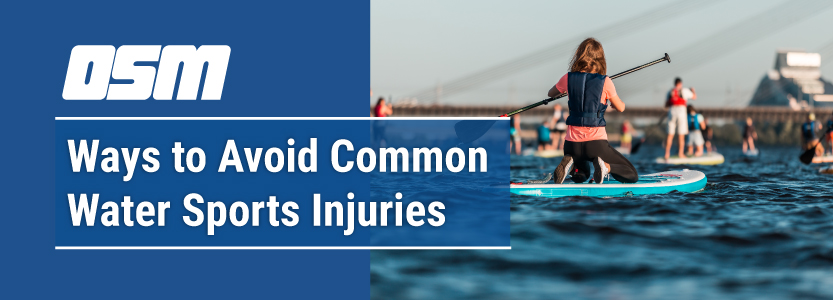Ways to Avoid Common Water Sports Injuries
Article featured on Fyzical
Water sports enthusiasts often experience the thrill of gliding across waves and performing daring maneuvers. However, these activities come with inherent risks of injury, especially for those new to the sport or pushing their limits. As physical therapists, we’ve seen our fair share of injuries stemming from water skiing, surfing, and wakeboarding. Here we’ll share insights on how to avoid the three most common types of injuries associated with these exhilarating water sports.
- Sprains and Strains
The abrupt movements and high-speed actions involved in water skiing, surfing, and wakeboarding can put immense strain on muscles and ligaments, leading to sprains and strains. To prevent these injuries, it’s crucial to warm up properly before hitting the water. Incorporate dynamic stretches that mimic the movements you’ll be performing during your activity. Focus on key muscle groups such as the quadriceps, hamstrings, calves, and shoulders.
It’s imperative that you ensure your equipment is properly maintained and fitted to your body. Ill-fitting gear can exacerbate strain on certain muscles and increase the risk of injury. Finally, listen to your body and know your limits. Pushing yourself too hard too quickly can lead to overuse injuries. Gradually increase the intensity and duration of your sessions to build strength and endurance safely.
- Impact Injuries
Water sports, particularly surfing and wakeboarding, involve navigating unpredictable waves and wakes, increasing the likelihood of impact injuries. Collisions with the water’s surface or with obstacles such as buoys or other watercraft can result in bruises, cuts, or more severe injuries like fractures or concussions.
To minimize the risk of impact injuries, always scout the area before starting your session, paying attention to potential hazards such as rocks, shallow areas, or crowded waterways. Invest in high-quality safety gear, including helmets and impact vests, especially when attempting more advanced maneuvers or riding in challenging conditions.
You should also focus on developing proper technique and body positioning to absorb impact effectively. Learning to fall safely can significantly reduce the severity of injuries. Practice falling in a controlled manner, tucking your chin to your chest and keeping your limbs close to your body to minimize the risk of injury upon impact.
- Overuse Injuries
Repetitive movements can place strain on specific muscle groups and joints, leading to overuse injuries such as tendonitis, bursitis, or stress fractures. These injuries often develop gradually over time due to repeated stress on the affected area.
While you will want to be on the water as much as possible this summer, incorporate cross-training activities into your fitness routine to strengthen supporting muscle groups and improve overall flexibility. Balance your water sports sessions with low-impact exercises such as swimming, yoga, or cycling to reduce strain on vulnerable areas and promote recovery.
Prioritize rest and recovery days to allow your body ample time to repair and rebuild tissues. Listen to any warning signs of overuse, such as persistent pain or swelling, and seek professional guidance from a physical therapist or sports medicine specialist if needed.
While water skiing, surfing, and wakeboarding offer thrilling experiences, it’s essential to prioritize safety and injury prevention. By warming up properly, practicing proper technique, wearing appropriate safety gear, and listening to your body, you can minimize the risk of common injuries and enjoy these water sports to the fullest. Remember, staying injury-free means more time on the water doing what you love.
The Orthopedic & Sports Medicine Center of Oregon is an award-winning, board-certified orthopedic group located in downtown Portland Oregon. We utilize both surgical and nonsurgical means to treat musculoskeletal trauma, spine diseases, foot and ankle conditions, sports injuries, degenerative diseases, infections, tumors and congenital disorders.
Our mission is to return our patients back to pain-free mobility and full strength as quickly and painlessly as possible using both surgical and non-surgical orthopedic procedures.
Our expert physicians provide leading-edge, comprehensive care in the diagnosis and treatment of orthopedic conditions, including total joint replacement and sports medicine. We apply the latest state-of-the-art techniques in order to return our patients to their active lifestyle.
If you’re looking for compassionate, expert orthopedic and podiatric surgeons in Portland Oregon, contact OSM today.
Phone:
Address
17355 Lower Boones Ferry Rd Suite 100A
Lake Oswego, OR 97035
Hours
Monday–Friday
8:00am – 4:30pm



